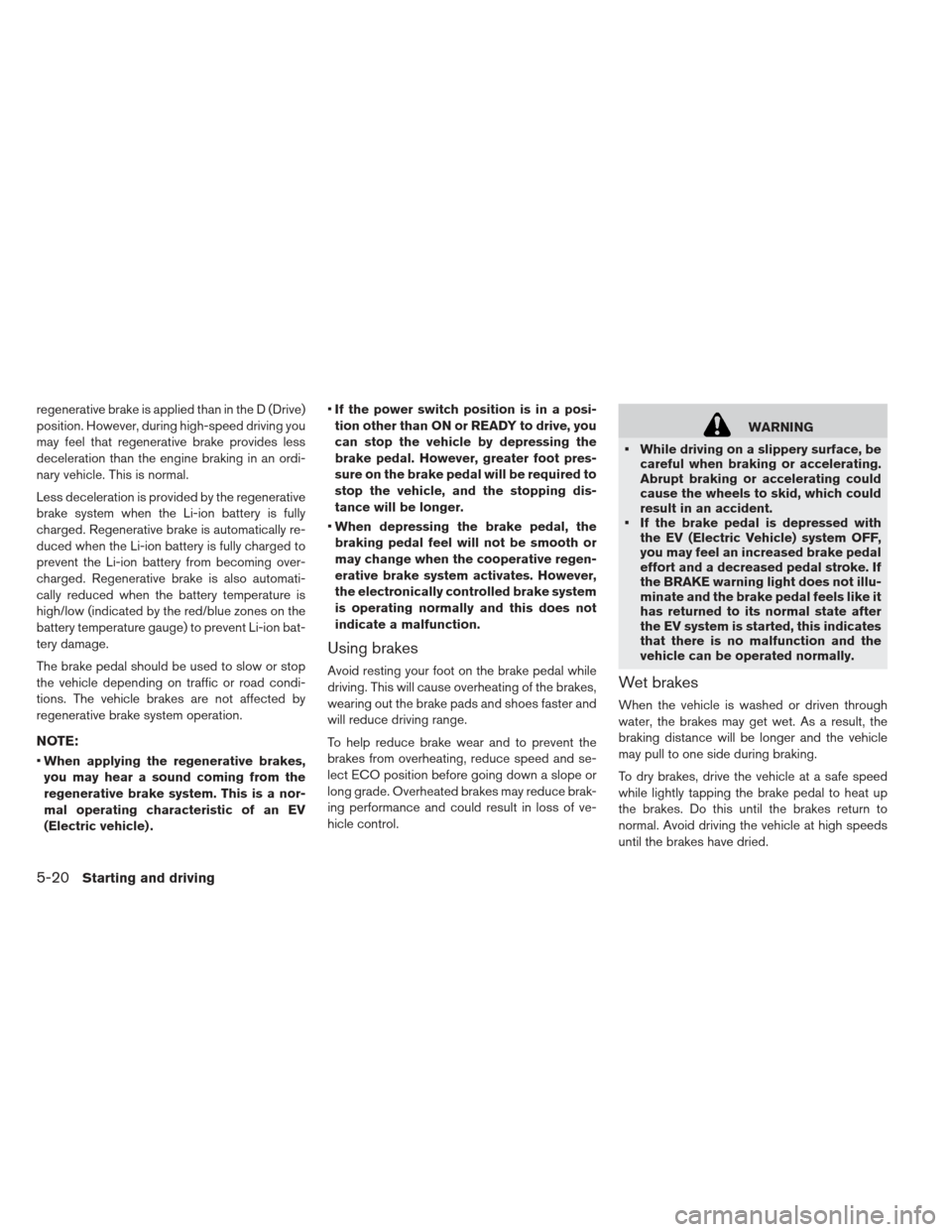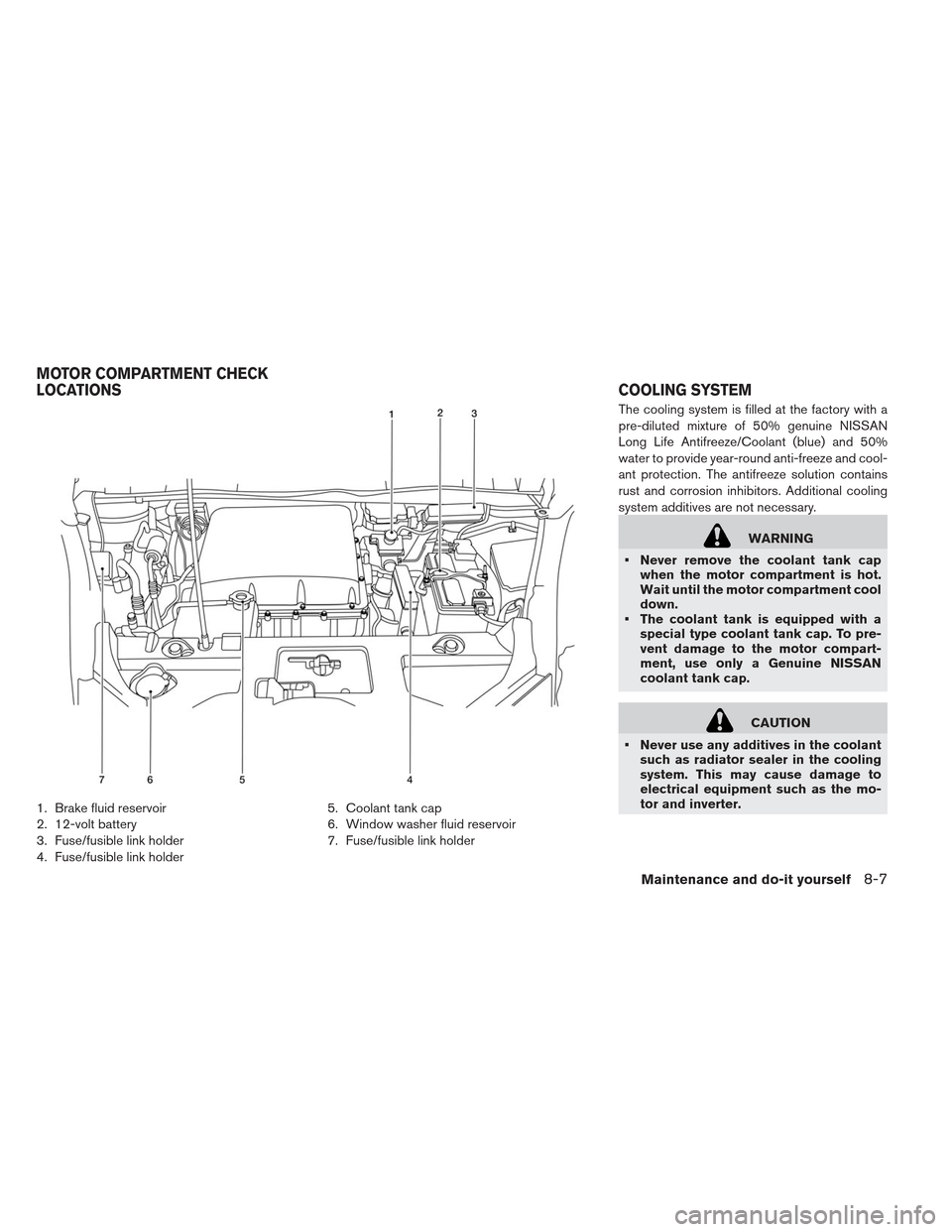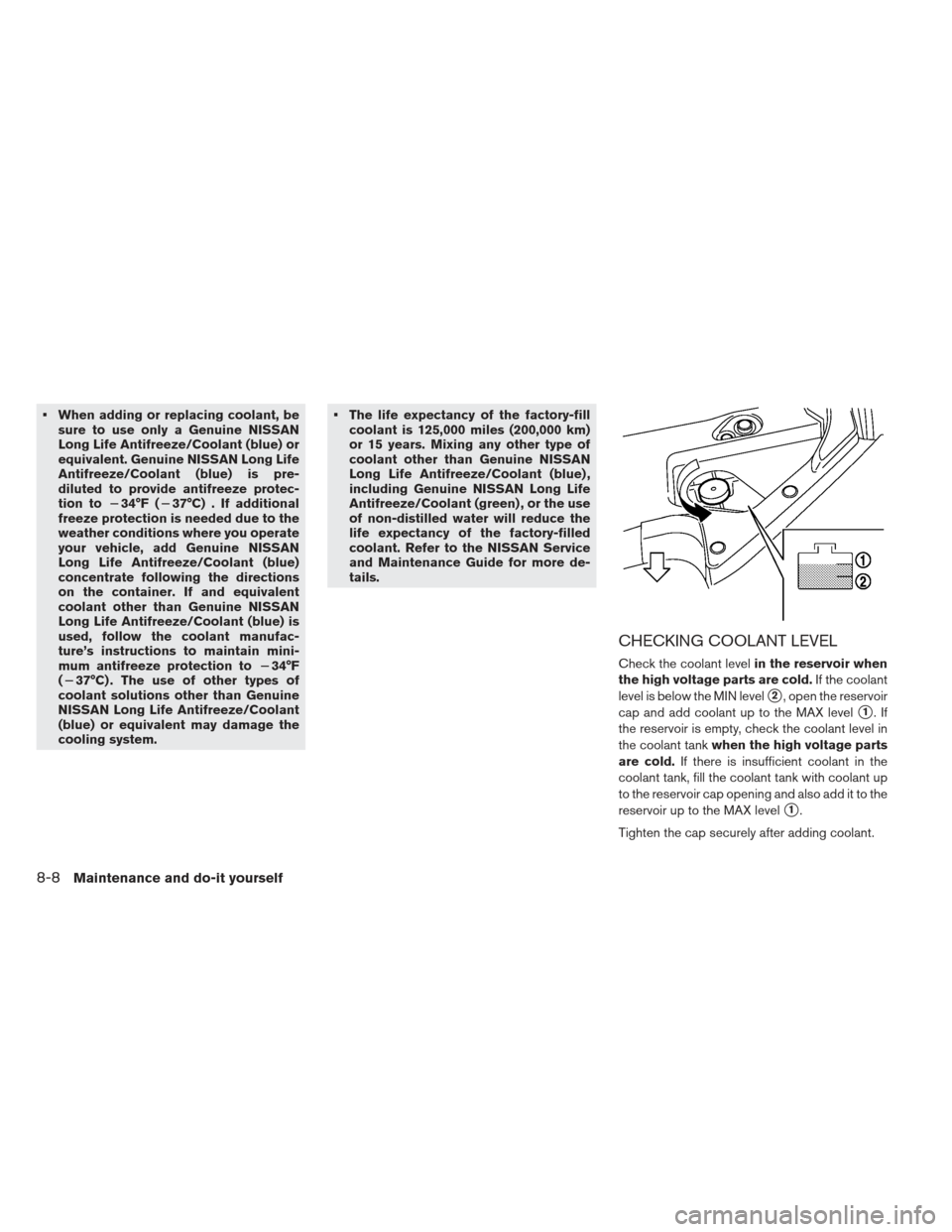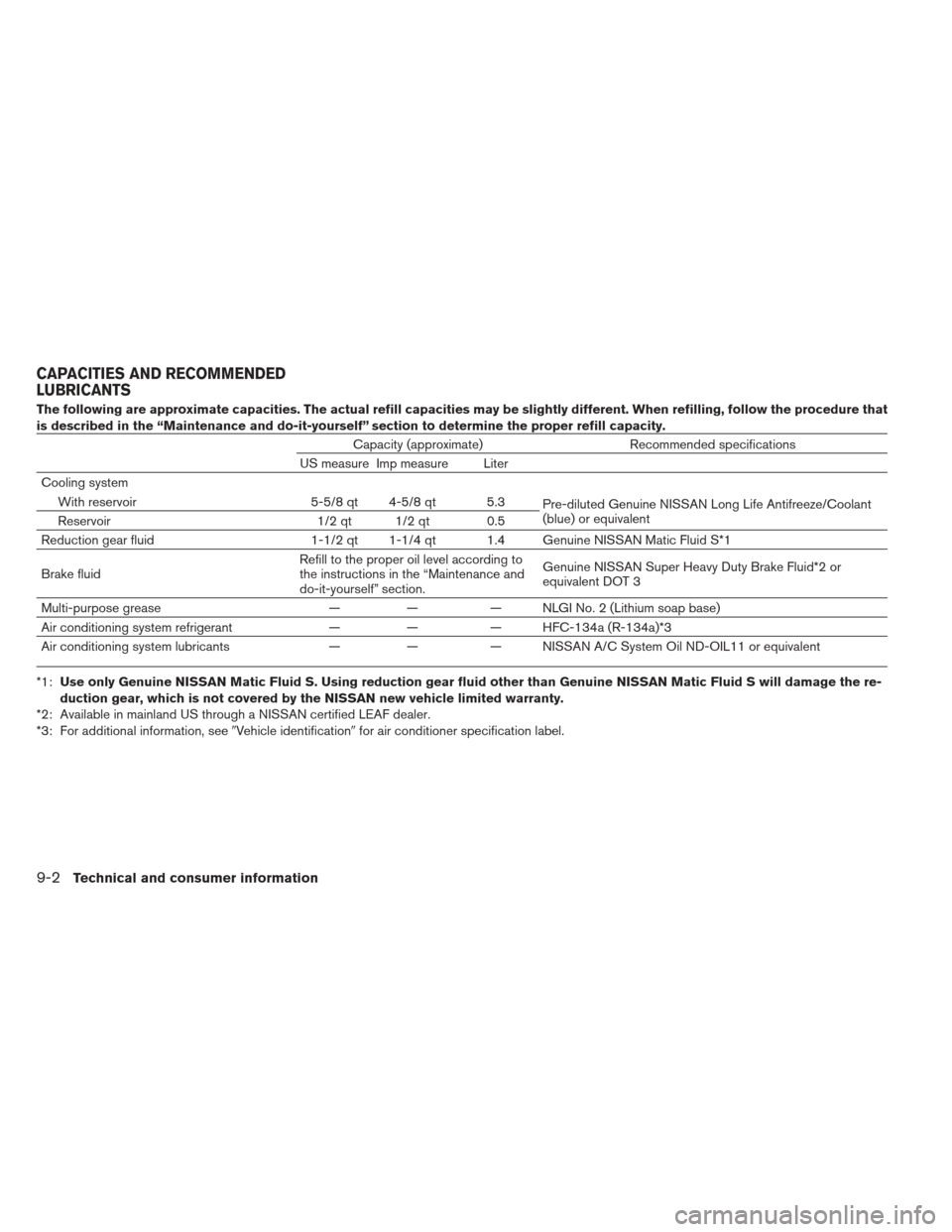Page 303 of 402

regenerative brake is applied than in the D (Drive)
position. However, during high-speed driving you
may feel that regenerative brake provides less
deceleration than the engine braking in an ordi-
nary vehicle. This is normal.
Less deceleration is provided by the regenerative
brake system when the Li-ion battery is fully
charged. Regenerative brake is automatically re-
duced when the Li-ion battery is fully charged to
prevent the Li-ion battery from becoming over-
charged. Regenerative brake is also automati-
cally reduced when the battery temperature is
high/low (indicated by the red/blue zones on the
battery temperature gauge) to prevent Li-ion bat-
tery damage.
The brake pedal should be used to slow or stop
the vehicle depending on traffic or road condi-
tions. The vehicle brakes are not affected by
regenerative brake system operation.
NOTE:
When applying the regenerative brakes,
you may hear a sound coming from the
regenerative brake system. This is a nor-
mal operating characteristic of an EV
(Electric vehicle) .
If the power switch position is in a posi-
tion other than ON or READY to drive, you
can stop the vehicle by depressing the
brake pedal. However, greater foot pres-
sure on the brake pedal will be required to
stop the vehicle, and the stopping dis-
tance will be longer.
When depressing the brake pedal, the
braking pedal feel will not be smooth or
may change when the cooperative regen-
erative brake system activates. However,
the electronically controlled brake system
is operating normally and this does not
indicate a malfunction.
Using brakes
Avoid resting your foot on the brake pedal while
driving. This will cause overheating of the brakes,
wearing out the brake pads and shoes faster and
will reduce driving range.
To help reduce brake wear and to prevent the
brakes from overheating, reduce speed and se-
lect ECO position before going down a slope or
long grade. Overheated brakes may reduce brak-
ing performance and could result in loss of ve-
hicle control.
WARNING
While driving on a slippery surface, be careful when braking or accelerating.
Abrupt braking or accelerating could
cause the wheels to skid, which could
result in an accident.
If the brake pedal is depressed with the EV (Electric Vehicle) system OFF,
you may feel an increased brake pedal
effort and a decreased pedal stroke. If
the BRAKE warning light does not illu-
minate and the brake pedal feels like it
has returned to its normal state after
the EV system is started, this indicates
that there is no malfunction and the
vehicle can be operated normally.
Wet brakes
When the vehicle is washed or driven through
water, the brakes may get wet. As a result, the
braking distance will be longer and the vehicle
may pull to one side during braking.
To dry brakes, drive the vehicle at a safe speed
while lightly tapping the brake pedal to heat up
the brakes. Do this until the brakes return to
normal. Avoid driving the vehicle at high speeds
until the brakes have dried.
5-20Starting and driving
Page 340 of 402

1. Brake fluid reservoir
2. 12-volt battery
3. Fuse/fusible link holder
4. Fuse/fusible link holder5. Coolant tank cap
6. Window washer fluid reservoir
7. Fuse/fusible link holderThe cooling system is filled at the factory with a
pre-diluted mixture of 50% genuine NISSAN
Long Life Antifreeze/Coolant (blue) and 50%
water to provide year-round anti-freeze and cool-
ant protection. The antifreeze solution contains
rust and corrosion inhibitors. Additional cooling
system additives are not necessary.
WARNING
Never remove the coolant tank cap when the motor compartment is hot.
Wait until the motor compartment cool
down.
The coolant tank is equipped with a special type coolant tank cap. To pre-
vent damage to the motor compart-
ment, use only a Genuine NISSAN
coolant tank cap.
CAUTION
Never use any additives in the coolant such as radiator sealer in the cooling
system. This may cause damage to
electrical equipment such as the mo-
tor and inverter.
MOTOR COMPARTMENT CHECK
LOCATIONS COOLING SYSTEM
Maintenance and do-it yourself8-7
Page 341 of 402

When adding or replacing coolant, besure to use only a Genuine NISSAN
Long Life Antifreeze/Coolant (blue) or
equivalent. Genuine NISSAN Long Life
Antifreeze/Coolant (blue) is pre-
diluted to provide antifreeze protec-
tion to �34°F (�37°C) . If additional
freeze protection is needed due to the
weather conditions where you operate
your vehicle, add Genuine NISSAN
Long Life Antifreeze/Coolant (blue)
concentrate following the directions
on the container. If and equivalent
coolant other than Genuine NISSAN
Long Life Antifreeze/Coolant (blue) is
used, follow the coolant manufac-
ture’s instructions to maintain mini-
mum antifreeze protection to �34°F
(�37°C) . The use of other types of
coolant solutions other than Genuine
NISSAN Long Life Antifreeze/Coolant
(blue) or equivalent may damage the
cooling system. The life expectancy of the factory-fill
coolant is 125,000 miles (200,000 km)
or 15 years. Mixing any other type of
coolant other than Genuine NISSAN
Long Life Antifreeze/Coolant (blue) ,
including Genuine NISSAN Long Life
Antifreeze/Coolant (green) , or the use
of non-distilled water will reduce the
life expectancy of the factory-filled
coolant. Refer to the NISSAN Service
and Maintenance Guide for more de-
tails.
CHECKING COOLANT LEVEL
Check the coolant level in the reservoir when
the high voltage parts are cold. If the coolant
level is below the MIN level
�2, open the reservoir
cap and add coolant up to the MAX level
�1.If
the reservoir is empty, check the coolant level in
the coolant tank when the high voltage parts
are cold. If there is insufficient coolant in the
coolant tank, fill the coolant tank with coolant up
to the reservoir cap opening and also add it to the
reservoir up to the MAX level
�1.
Tighten the cap securely after adding coolant.
8-8Maintenance and do-it yourself
Page 369 of 402

The following are approximate capacities. The actual refill capacities may be slightly different. When refilling, follow the procedure that
is described in the “Maintenance and do-it-yourself” section to determine the proper refill capacity.
Capacity (approximate)Recommended specifications
US measure Imp measure Liter
Cooling system With reservoir 5-5/8 qt 4-5/8 qt 5.3
Pre-diluted Genuine NISSAN Long Life Antifreeze/Coolant
(blue) or equivalent
Reservoir 1/2 qt 1/2 qt 0.5
Reduction gear fluid 1-1/2 qt 1-1/4 qt 1.4 Genuine NISSAN Matic Fluid S*1
Brake fluid Refill to the proper oil level according to
the instructions in the “Maintenance and
do-it-yourself” section.Genuine NISSAN Super Heavy Duty Brake Fluid*2 or
equivalent DOT 3
Multi-purpose grease —— — NLGI No. 2 (Lithium soap base)
Air conditioning system refrigerant —— — HFC-134a (R-134a)*3
Air conditioning system lubricants —— — NISSAN A/C System Oil ND-OIL11 or equivalent
*1: Use only Genuine NISSAN Matic Fluid S. Using reduction gear fluid other than Genuine NISSAN Matic Fluid S will damage the re-
duction gear, which is not covered by the NISSAN new vehicle limited warranty.
*2: Available in mainland US through a NISSAN certified LEAF dealer.
*3: For additional information, see �Vehicle identification�for air conditioner specification label.
CAPACITIES AND RECOMMENDED
LUBRICANTS
9-2Technical and consumer information